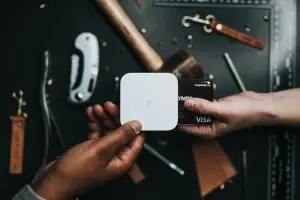Get access to exclusive updates, the latest news and the inside scoop 🍨

What Are 12 Checkout Process Optimization Tips?
We are going to reveal the 12 best checkout process optimization tips that will enable you to capture shoppers at the last hurdle.
Don't want to read the whole article? 😏Click here for chapters
- Checkout Process Optimization 💥
- Quick Answer
- N0.1: Guest Checkout 🛒
- N0.2: Free Shipping
- N0.3: Payment and Shipping 💳
- N0.4: Google Auto-Address
- N0.5: 1-Click Checkout 🖱️
- N0.6: Security Badges
- N0.7: Mobile-Friendly Design 📱
- N0.8: Reduced Form Fields
- N0.9: Live Chat Support 💬
- N0.10: Psychological Triggers
- N0.11: Checkout Flow ➡️
- N0.12: Cross-Selling and Up-Selling

Written by Madeleine
Checkout Process Optimization 💥
Did you know that the average cart abandonment rate for ecommerce businesses is 69.82%?
This means that just three out of ten browsers who add an item to their cart will finish their online transaction and as we’re sure you will know, these losses can quickly mount up, costing merchants thousands of dollars in lost sales.
Your business could have the world's best product page, but if online shoppers are dissatisfied during the checkout process, converting these users to paying customers can be quite the challenge.
So, we’re guessing that you’ve clicked on today’s guide to learn more about how your store can brush up on its checkout process optimization while generating further online revenue?
If this sounds familiar, you’ve come to the right place.
Quick Answer
Before we delve into the crux of today’s guide, it’s important to understand the definition of checkout process optimization and how it can serve a business on Shopify.
So, what does checkout process optimization mean? This term simply refers to a retailer's method for increasing the conversion rate of an online business.
Throughout the checkout process, the goal is to reduce distractions and enhance trust among browsers, leading every customer to a purchase confirmation email and away from the likelihood of an abandoned cart.
So, why is checkout process optimization so important for merchants to implement?
Well, the first reason is that the default checkout process likely isn’t the best-optimised option where customer experience is concerned.
Did you know that around 17% of consumers will abandon their cart because the checkout procedure is too complicated?
That’s a lot of orders and online revenue that your business could be missing out on due to a poorly configured checkout.
However, by taking a few basic checkout process optimization steps, the new and strategic process will encourage customers to spend more money, enhancing the average order value and generating greater online revenue for your store.
The tips we will cover in today's guide are:
- Guest checkout
- Free shipping
- Payment and shipping
- Google-auto address
- 1-click checkout
- Security badges
- Mobile-friendly design
- Reduced form fields
- Live chat support
- Psychological triggers
- Checkout flow
- Cross-selling and up-selling
N0.1: Guest Checkout 🛒
It’s no secret that ecommerce retailers require a sufficient amount of information from first-time buyers, that is if they hope to re-target and turn these users into loyal customers in the future.
Keeping such information in an online account would make future purchases much easier to complete, however, asking shoppers to create an online account is thought to drive around 34% of browsers to abandon their cart.
John Cheng, the Founder and CEO of Baotris stated:
“With ecommerce platforms becoming more and more popular, you don't want to discourage one-time shoppers.
A lot of people may see the process of creating an account as an obstacle because they are looking for a fast and easy way to buy the product they want.”
So, the solution here is to offer your customers a way to complete their transactions without having to enter unnecessary personal information such as their date of birth or password.
Don’t just take our word for it, take it from Public - Supply, an online retailer that provides shoppers with the option to log in to their account without forcing new customers to create an account before making a purchase.
N0.2: Free Shipping
According to a Forrester study conducted on behalf of Shopify, free shipping has an impact on purchases for three-quarters of international shoppers, with 58% of these consumers expecting to be offered free next-day delivery with their purchase.
So, how can you be sure to meet the expectations of your customers throughout the checkout process?
We here at Karmoon would recommend utilising; shipping-related messages, badges and progress indicators to demonstrate that your business is meeting the expectations of potential buyers.
Daniel Bari, the Marketing Director at Dreamland Jewelry commented:
“The single biggest impact was free shipping on all orders, which resulted in a 37% uplift in conversions.”
Also, take a cue from Partake Foods, the company that established a minimum order threshold for customers to qualify for free shipping that encouraged 58% of customers to spend more when browsing their online store.
How do they achieve this? Well, progress bars in the shopping cart prompt customers to reach the $29.99 threshold, increasing the retailer’s average order value while ditching extra shipping costs for customers. So, it’s a win-win for everyone.
N0.3: Payment and Shipping 💳
When purchasing products online, consumers are demanding more and more options to the point that 7% of shoppers will abandon the checkout process if the store they are browsing does not accept their preferred method of payment.
Therefore, to avoid this little hiccup, we’d recommend providing a variety of payment options across your ecommerce website, such as:
- Debit or credit cards.
- Shopping apps, such as Shop Pay and PayPal.
- Digital wallets, such as Apple Pay, or Google Pay.
- Buy now and pay later options through the likes of Klarna.
Jen Greenlees, the owner of Sydney So Sweet, put this checkout optimization tip into practice and stated:
“Buyers are looking for these options when paying for an order.”
As a result of this store's checkout modification, the average order value increased by 21% and Jen noticed the correlation between various payment options offered and a lower abandoned cart rate.
N0.4: Google Auto-Address
Did you know that Google Autocomplete reduces typing by filling in a customer’s shipping address?
To take advantage of this handy checkout process optimization tool, simply enable this feature on your online store to have it automatically populate a customer’s; town, state and ZIP code based on the first line of their address.
However, Google Autocomplete is not only 20% faster than manually inputting an address, but it also reduces errors across mobile devices.
Simply put, when customers can easily order and acquire an item, their overall satisfaction rises and so will a brand’s online revenue. So, everyone is happy!
N0.5: 1-Click Checkout 🖱️
"Less is more" is the best way to summarise the ideal checkout process optimization experience, as fewer stages often create less friction for online shoppers, increasing the likelihood of browsers turning into loyal buyers.
Ann McFerran, the CEO of Glamnetic commented:
“Abandoned carts are often due to people changing their minds from having to fill out too much information.
People want as few steps as possible and the more streamlined your system is, the less likely they are to rethink their purchase and abandon their cart.”
With a 1-click checkout, shoppers will only need to enter their information once, which will be saved and auto-filled during their next visit.
Even if they've never shopped with your brand before, Shop Pay allows 100 million customers to check out with a single click, as information from other Shop carts is saved, resulting in a smoother customer experience and x1.72 more conversions generated.
Sophie Gibson, from PR and Communications at S’wheat noted:
“We offer Shop Pay because it’s quick, secure, seamless and accepts all major card providers, so it makes things a lot easier for everyone.”
N0.6: Security Badges
Customers are concerned about their online privacy, with 17% of shopping carts abandoned due to a lack of trust in a website.
So, where do security badges come in? Well, security badges emphasise why an online browser should put their trust in your business.
So, to increase conversions and online revenue for your brand be sure to highlight the following badges during the checkout process:
- SSL certificates
- Payment badges
- Antivirus software logos
- Money-back guarantees
- Customer reviews
Lily Wili, the CEO of Ever Wallpaper commented:
“Trust badges not only strengthen your brand’s legitimacy but also provide your customers with a sense of security that your company will deliver on its commitments.”
Take a peek at the cart flow on the Nick Mayer art store for an illustration of how security badges are employed for checkout process optimization.
In a nutshell, this store demonstrates how customer reviews and recognised checkout logos reassure potential customers that the business can be trusted with sensitive information.

N0.7: Mobile-Friendly Design 📱
By 2024, an estimated $621 billion would have been spent by 187.5 million people across mobile devices.
So, if you’re looking to capture some of that online revenue for your business, the checkout process needs to be mobile-friendly.
Simply put, this means:
- Minimising code to deliver fast loading speeds.
- Having a responsive design that automatically resizes for different screen ratios.
- Using large mobile-friendly buttons, such as Add to Cart and Checkout.
Benjamin Sehl, the Co-Founder of KOTN commented:
“The majority of our customers today are discovering new products on the go on their mobile devices and if they have to fill out a form, we’ve lost them.”
N0.8: Reduced Form Fields
If truth be told, a time-consuming checkout process makes consumers work harder to complete their purchases, but if you want our advice, we’d recommend reducing the number of fields on your store’s checkout form, gathering only the essential information.
According to Baymard's checkout usability research, most ecommerce websites only require eight fields on their checkout form, even though the average store has over 12.
"Displaying a huge amount of form fields intimidates users, resulting in unnecessary checkout abandonment" the study stated.
Zarina Bahadur, the CEO and Founder of 123 Baby Box added:
“When it comes to the cart and basket pages, it’s important to keep things as simple as possible.
Provide a very clear overview of what the user has added to the cart and indicate the next step, as well as how they can make changes to their order.
Only include custom fields if they are necessary since they naturally create more friction for shoppers.”
N0.9: Live Chat Support 💬
During the checkout process, it's normal for customers to have inquiries about their purchases.
So, to keep customers from leaving your store, be sure to resolve their complaints throughout the checkout process.
Concerned about a query overload? Simply respond to frequently asked questions with a chatbot on your store's checkout page.
Did you know that a whopping 70% of shoppers will use chatbots to communicate with brands before making a purchase?
SuitShop provides instant checkout process optimization solutions for; sizing, shopping and return-related queries for potential customers to read.
Not only does this reduce the burden on their customer service team, but real-time responses give shoppers less time to debate whether or not they should proceed with the purchase.
N0.10: Psychological Triggers
When consumers debate whether to buy something online, they are engaged in a psychological battle between “Is this item worth the money?” and “Do they need the product?”.
To help nudge things along, we’d suggest implementing psychological triggers on your store's checkout page to encourage your customers to answer "yes" to the questions above.
What psychological triggers should your checkout include? Check out the list below for some inspiration:
- Scarcity: “Grab this before stock runs out”
- Urgency: “Order in the next 10 minutes to secure next-day delivery”
- Social proof: “18 people bought this item in the last hour”
This checkout process optimization tip is utilised and implemented by Tentree, as this retailer emphasises how it plants trees after every transaction just beneath the checkout button.
This demonstrates to environmentally conscious customers why purchasing from a sustainable brand is a good idea.
N0.11: Checkout Flow ➡️
During the stages of checkout, online buyers will naturally view numerous pages, from selecting a product to completing their purchase, but with more consumers demanding a user-friendly shopping experience, consumers will want to know how far along they are in the checkout flow.
Therefore, we would recommend implementing a progress bar within your store’s checkout configuration to; improve user experience, decrease cart abandonment and increase online revenue for your brand.
For instance, Fussy has a rather complicated checkout flow, as customers are required to select a; deodorant case, subscription plan and scent before adding the item to their cart.
However, this sophisticated checkout experience does not work against the business as customers are kept informed throughout the process via a progress bar at the bottom of the page.
As a result, this tool has demonstrated its influence when it comes to encouraging customers to complete the process.
N0.12: Cross-Selling and Up-Selling
Optimising the checkout process entails more than just lowering cart abandonment rates. With cross-sells and up-sells, you may increase the amount of money people spend on your store and increase its online revenue in the process.
So, how does cross-selling work? Cross-selling works by simply suggesting an item that compliments another in a customer's cart.
For example, an online fashion retailer could cross-sell matching trousers or jewellery with a t-shirt to boost the customer’s average order value.
Up-selling, on the other hand, offers a higher-priced product that is identical to the one already in the shopper's cart.
Some of the best up-selling and cross-selling apps on Shopify include:
So, what are your thoughts on our guide to the best 12 checkout process optimization tips? Reach out and let us know.
If you’re actively looking to work with a Shopify agency designer or developer to assist you with your business, we’d love to hear from you. Get in touch to get started!
Get Started with Shopify
Looking to get started with Shopify? Take advantage of Shopify's 14-day free trial, no credit card is required.
If you're actively looking to work with a Shopify agency designer or developer to assist you with your business, we'd love to hear from you. Get in touch to get started!
Want to read some more?
Have a look over more posts related to this one















